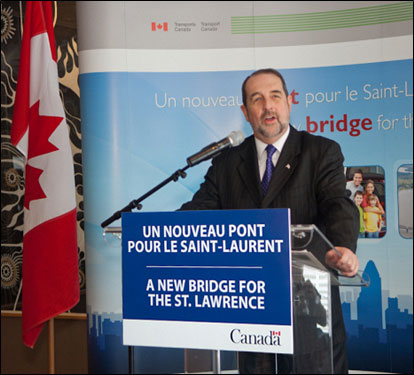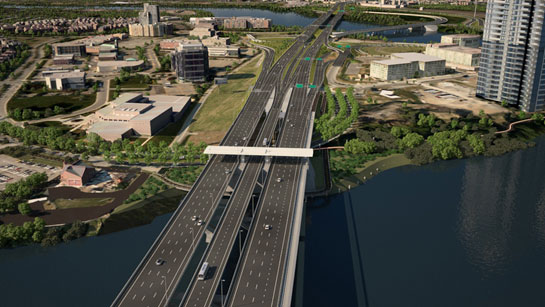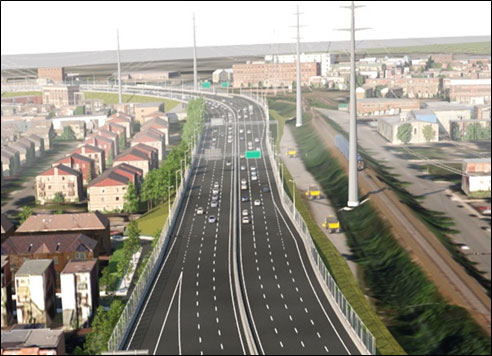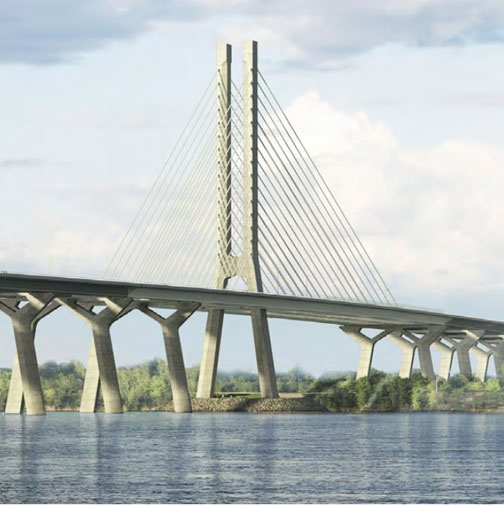New Bridge for the St. Lawrence Corridor Project - Presentation: Announcement of the Preferred Proponent - April 15, 2015
The Powerpoint presentation is available for download:
Help on accessing alternative formats, such as PDF, PPT and ZIP files, can be obtained in the alternate format help section.
- Announcement of the Preferred Proponent (Size: 1.31 MB)
Context

Context - New Bridge Project
- On October 5, 2011, Government of Canada launched new Bridge project
- One of the largest PPP projects brought to market in Canada
- $3 to $ 5 billion project, with an operational period of 30 years
- One of the most aggressive procurement and construction schedules seen in the industry
- Expected to create 30,000+ jobs
- To date, all project and procurement milestones have been on-time or ahead of schedule
Project Team and Key Stakeholders
Project Advisors
- Arup Group Limited
- Dentons
- PricewaterhouseCoopers
- Steer Davies Gleave
Key Stakeholders
- The Jacques Cartier and Champlain Bridges Incorporated
- City of Montréal
- Québec Ministry of Transport
- The St. Lawrence Seaway Management Corporation
- City of Brossard
- City of Longueuil
- Quebec Ministry of Sustainable Development Environment and the Fight against Climate Change
- Canadian National Railway
- Hydro Québec
- Caisse de dépôt et placement du Québec
- Agence métropolitaine de transport
The Project
Project Components





Highway 15 – Context and Challenges




- Replacement and widening of existing highway (3.0 km)
- Coordination with adjacent Turcot Interchange Project
- Requires proper traffic management planning
- Property acquisitions on schedule
- All residential properties acquired
- Agreements reached with Québec, Montréal, Brossard
Île-des-Soeurs – Context and Challenges
- Replacement and widening of existing highway (1.1 km)
- Replacement and deconstruction of existing Île-des-Soeurs Bridge (470 m)
- Temporary bridge-causeway built to expedite schedule
New Bridge – Context and Challenges
- Three separate corridors
- 3.4 km in length
- 3 lanes in each directions
- Additional two lanes for buses or future LRT
- 42 month Construction Schedule
New Bridge – Architectural Considerations
- Established architectural quality advisory panel
- Comprised of notable local architects and engineers
- Retained world-class bridge architects supported by local experts:
- Dissing and Weitling Architecture
- Provencher Roy
- Mandatory Definition Design
- Prescribed architectural features combined with flexibility of materials and methods
Project Structure
- Public Private Partnership where private partner designs, builds, finances, operates and maintains the project
- Performance-based project agreement developed, where expertise and innovation of private sector and discipline and incentives of capital markets are leveraged to deliver optimal project
- Major share of project risks, including costs overruns, schedule delays, and unexpected maintenance transferred to private sector
- Revenue risk retained by Canada, long-term financing solution where significant capital (equity, long term debt) is at risk post design build substantial completion
- Payments made at set milestones and over time only if asset is properly maintained and performs well
- Operating period of 30 years where cost of asset is known upfront, meaning that taxpayers are not on the hook for costs that arise unexpectedly during the contract period
The Procurement Process
Procurement Strategy
A RIGOUROUS, FAIR, OPEN AND TRANSPARENT PROCESS TO OBTAIN BEST VALUE FOR TAXPAYERS
- Exceed the best practices in the P3 industry
- Early and continuous industry engagement
- Rigorous and effective governance
- World class third party advisors
to achieve the highest standards of integrity, timeliness and best value
Two Step Procurement Process
- Request for Qualifications
- March 17 to May 7, 2014
- 6 responses from international consortia received (55 entities in total)
- 3 highest respondents invited to RFP Stage
- Request for Proposals
- Launched on July 18, 2014
- Technical proposals received on Feb 11, 2015
- Financial proposals received on April 1, 2015
- 9 series of individual meetings held with proponents
- Two rounds of comments on draft Project Agreement held to ensure best possible industry engagement
- Launched on July 18, 2014
Three Shortlisted Proponents
Signature on the St. Lawrence Group
- SNC-Lavalin
- Role: Equity, O&M, DBJV
- ACS Infrastructure
- Role: Equity, O&M
- HOCHTIEF PPP Solutions
- Role: Equity, O&M
- Dragados
- Role: Construction
- Flatiron Construction
- Role: Construction
- MMM Group
- Role: Design
- TY Lin International
- Role: Design
- International Bridge Technologies
- Role: Design
Saint-Laurent Alliance
- Kiewit
- Role: Equity, O&M, Construction
- Macquarie Capital
- Role: Equity, O&M
- Skanska
- Role: Equity, O&M, Construction
- Aecon
- Role: Equity
- WSP
- Role: Design
- Buckland and Taylor
- Role: Design
- Parsons Brinckerhoff Halsall
- Role: Design
St. Lawrence New Bridge Partnership
- Obrascón Huarte Lain
- Role: Equity, O&M, Construction
- DIF
- Role: Equity
- Acciona
- Role: Equity, O&M, Construction
- Samsung C&T
- Role: Equity, Construction
- Hatch Mott MacDonald
- Role: Design
- Stantec Consulting
- Role: Design
- Ramboll
- Role: Design
- Mainroad Infrastructure
- Role: O&M
Request for Proposals (RFP)
- The RFP stage determines the lowest cost, compliant proposal to be identified as the Preferred Proponent
- The RFP Evaluation occurred in two phases:
- Evaluation of Technical Proposals against established mandatory and rated criteria for compliance
- Evaluation of Financial Proposals against established rated criteria for compliance and lowest cost. Only technically compliant proposals are evaluated for financing capability
- Technical Proposals were evaluated based on 8 key elements:
- Time Management
- Management
- Design
- Construction
- Durability
- Architectural Guidelines
- Operations, Maintenance and Rehabilitation
- Tolling Approach
- Financial Proposals were evaluated based on 2 key elements:
- Achievability and Credibility of Financing Plan and lowest cost
Evaluation Principles
- Independent and Unbiased
- Evaluators did not have subordinate relationships
- All conflicts of interest disclosures rigorously assessed by an impartial forum of senior federal executives (Relationship Review Committee)
- Segregation of Information
- Complete segregation of Technical/Financial Proposals
- Evaluation committee comprised of separate teams of experts
- Conducted by Experts and Overseen by Professionals
- Facilitated by a government contracting expert and overseen by a Fairness Monitor
- Reputable subject matter experts from both the public and private sectors
- Mandatory training for all evaluators
Rigorous Oversight
- Relationship Review Committee
- Impartial forum of senior federal executives to assess relationships between and among individuals involved in the NBSL project including evaluators to mitigate potential conflicts of interest
- Independent Fairness Monitor
- Formal oversight of the process, ensure an independent validation and attest to the fairness of the process. Attends all sessions as an observer and raises any fairness issues
- Technical Oversight Committee
- Review and challenge function of technical evaluation and assumptions
- Evaluation Review Committee
- Final review of evaluation reports to ensure consistent application of evaluation criteria and evaluator remarks are adequately substantiated
- Integrity Framework
- All Proponents required to comply with PWGSC Integrity Provisions
Key Next Steps
- April 2015 – Early Works Agreement Executed
- April/May 2015 – Early Works Begin
- June/July 2015 – Project Agreement Executed
- June/July 2015 – Construction Begins
- Summer/Fall 2015 – Technical Briefing and Release of Project Documents
- Date modified:
